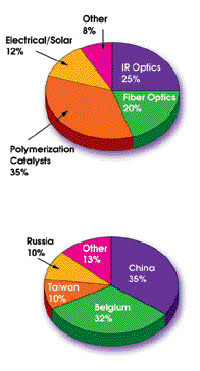Paula M. Powell
With Belgium-based Umicore SA's purchase of key germanium assets from EaglePicher of Quapaw, Okla., the domestic makeup of the market for the strategic material has shifted. Acquired for roughly $15 million, the facility, now Umicore Optical Materials USA Inc., produces products primarily for IR optics and fiber optics. Besides some recycling, production capability includes Ge optics, GeCl4 and some GeO2. Umicore USA Inc., which also has a GeCl4 facility in North Carolina, is now the largest domestic producer of optical-grade germanium.
Germanium, which remains on the US Defense Logistics Agency's list of strategic and critical materials, has a variety of photonic applications, including:
- Optical fiber. GeCl4 is a doping agent in the core of a silica glass fiber
- IR applications. Ge and GeO2 are transparent to the IR and thus useful lens materials for IR detectors and night-vision scopes. Other applications include wide-angle camera lenses and microscope objectives.
Other areas of interest include CO2 laser lenses and solar cell materials. Steve Westfall, vice president of EaglePicher Technologies LLC in Joplin, Mo., reports that the company has retained its germanium substrate facility in Miami, Okla., which produces germanium wafers for solar panel applications.
According to analyst John D. Jorgenson at the US Geological Survey in Reston, Va., worldwide germanium resources are associated with zinc and lead-zinc-copper sulfide ores.
Michael S. Hulen, president of Novotech in Acton, Mass., which produces germanium products for IR applications, added that roughly 15 to 20 percent of total demand, including optical-grade germanium, is now met by material recycled from coal ash and other sources. The Defense Logistics Agency also has an annual sell-off of some of the 41,460 kg stockpiled, with last year's sales falling way below the set limit.
US refinery production of germanium last year was roughly 15,000 kg. Jorgenson estimates that the domestic use pattern was roughly 40 percent IR optics, 30 percent fiber optics, 15 percent electrical/solar applications, 10 percent other uses and 5 percent polymerization catalysts. Worldwide consumption patterns differ somewhat (see figure).

 In its heyday, fiber optics accounted for as much as 60 percent of demand, so it is no surprise that demand dropped significantly last year -- the 2002 year-end price for material released from the National Defense Stockpile was $461/kg, down by almost half from the beginning of the year.
In its heyday, fiber optics accounted for as much as 60 percent of demand, so it is no surprise that demand dropped significantly last year -- the 2002 year-end price for material released from the National Defense Stockpile was $461/kg, down by almost half from the beginning of the year.
Although near-term demand for the material will remain weak, based on factors such as higher recycling rates and a continued oversupply of both germanium metal and oxide, Jorgenson and colleagues predict that germanium prices will remain fairly steady, fueled by several factors. The fiber optics market appears to be stabilizing somewhat. In addition, a drop-off in telecom demand has been countered to a degree by growing defense and homeland security demand for IR technology, something Hulen thinks could help US companies.
Even Umicore's strengthened position in the market could affect pricing long term. "Any takeover of a domestic downstream producer [EaglePicher's optical-grade Ge facility] by a major upstream producer can have two opposing effects on the market," Jorgenson said. "It tends to have a stabilizing effect in that one company is now responsible for upstream and downstream processing, and, therefore, another market interface on the road to a final project is avoided. On the other hand, it tends to concentrate control of the commodity in fewer hands and could possibly lead to lowered supply and higher prices."
For more details, visit http://minerals.usgs.gov/minerals/pubs/commodity/germanium.
https://www.eaglepicher.com/